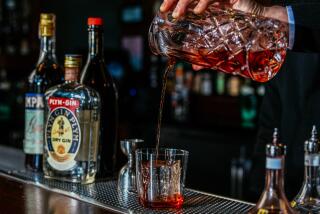Barreling On
- Share via
A hundred and fifty years ago, everything from nails to molasses was shipped and stored in barrels. They were air-tight, water-tight and easy to handle by pre-forklift standards. If you had to shift a 500-pound barrel, you could just roll it.
These days, metal and plastic containers have replaced barrels for nearly every purpose but aging wine, whiskey and brandy. But barrels are essential for that, and above all in the case of Bourbon, which gets 60% of its flavor from wood aging.
In the old days, a cooper might make a dozen barrels a day using hand tools with names like crozes, howels and chamfer knives. A modern operation such as Blue Grass Cooperage, which supplies Brown-Forman Distillers, can turn out 1,500 Bourbon barrels a day. It clanks and roars like any other factory, and the air is full of sawdust and the barbecue-like smell of charring oak, but essentially the process is unchanged from the Middle Ages.
It starts with inch-thick planks of white oak which have been dried for three to six months. These are cut strictly from the heartwood, because the sapwood is porous, so coopers have to accept an inconvenient variety of widths from one to five inches. When the planks enter the cooperage, machines shave them into the tapering, slightly convex shape of a barrel stave and cut a notch known as the croze at either end for seating the barrel heads.
Then silent, intent men, working very fast (each has a quota of 277 barrels a day), “raise” barrels by arranging staves upright in a metal ring. It takes the human eye to pick the last stave or two to complete a barrel, because of the varying widths. Then a machine clamps a wrought iron ring, called a truss hoop, around the end.
At this point, the staves are still straight, so the half-formed barrel is steamed to make the wood pliable. Then another truss hoop is fitted around the other end and the staves assume the familiar bulging barrel shape.
Now the staves are charred inside by great leaping gas flames for about a minute. There are four degrees of char. Most Bourbon distilleries use the No. 3 char, but Jim Beam and Wild Turkey use No. 4, known as “alligator skin” because of its texture.
The barrel heads have been assembled separately, from planks fitted together with wooden dowels, then sawed into the proper round shape. The heads also get charred on one side.
When the heads are seated in the barrels, the truss hoops are replaced by regular barrel hoops and a bung hole is drilled in the widest stave. The bung is made from poplar, a softer wood than oak, for the same reason that a cork is softer than the glass of a wine bottle--so it will conform to the shape of the hole.
Finally, the barrels are tested by putting a gallon or so of water in them under pressure. If there’s a leak, it’s repaired by hand, the medieval way--the hoops are knocked off and a sound stave is fitted in place of the leaky one, using old-fashioned mallets, stave spreaders and hoop drivers. Just to be on the safe side, the cooper may shim the stave on either side with a bit of corn husk.
Then the barrels are immediately shipped to the bottling plants.
“Everything about Bourbon is lengthy and leisurely except for this one step,” says Paul Smith, Bluegrass Cooperage’s director of operations. “Once the barrels are made, they’re nearly all filled with whiskey within 48 hours.”
More to Read
Sign up for The Wild
We’ll help you find the best places to hike, bike and run, as well as the perfect silent spots for meditation and yoga.
You may occasionally receive promotional content from the Los Angeles Times.






